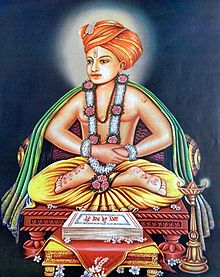دنیانشوار
دیناندئو ویتالپانت کولکارنی | |
|---|---|
 | |
| عنوان(ها) | سنت دیانشوار |
| اطلاعات شخصی | |
| زاده | دنیانشوار Janmashtami, 1275 CE Apegaon, Yadava dynasty (present-day Paithan Taluka, Aurangabad, Maharashtra, هند) |
| دین | هندوئيسم |
| والدین |
|
| فلسفه | آدوایتا، وارکاری |
| مرتبه | |
| گورو | Nivruttinath (elder brother) |
| آثار ادبی | دنیانشواری، امروتانوبهاو، چانگدو پااسشتی، هاریپات، شعر عبادی آبهنگ |
| افتخارات | سنت (قدیس)، دیو (خدا) و ماولی (مادر) |
سنت دنیانشوار (تلفظ مراتی: [d̪ɲaːn̪eʃʋəɾ])، و همچنین با نامهای جنانشوار، جنانادوا، دنیاندف یا ماولی یا دنیانشوار ویتال کولکارنی(۱۲۷۵–۱۲۹۶) شناخته میشود،[۱] او قدیس، شاعر، فیلسوف و مراتی هندی قرن سیزدهم بود. او در زندگی کوتاه ۲۱ ساله خود، دنیانشواری (تفسیری بر باگاواد گیتا) و امروتانوبهاو را تألیف کرد.[۲] اینها قدیمیترین آثار ادبی باقی مانده به زبان مراتی هستند و به عنوان نقاط عطف در ادبیات مراتی محسوب میشوند.[۳] ایدههای سنت دنیانشوار منعکس کننده فلسفه غیر دوگانه آدوایتا ودانتا و تأکید بر یوگا و باکتی نسبت به ویتوبا، تجسم لرد ویشنو است.[۴] میراث او الهام بخش شاعران قدیس مانند اکنات و توکارام بود و او یکی از بنیانگذاران سنت جنبش وارکاری (ویتوبا - کریشنا) باکتی هندوئیسم در ماهاراشترا است.[۵][۶]
زندگینامه
[ویرایش]دنیانشوار در سال ۱۲۷۵ (در روز فرخنده کریشنا جانمشتامی) در یک خانواده مراتی زبان دشاستا برهمین در روستای آپگان در سواحل رودخانه گوداواری در نزدیکی پایتان در ماهاراشترا در زمان سلطنت راماداواراوا، پادشاه یاداوا، به دنیا آمد.[۷][۸]
جزئیات بیوگرافی زندگی سنت دنیانشوار در نوشتههای شاگردانش، ساتیامالانات و ساچچیداناند، حفظ شدهاست.[۹] روایات مختلف گزارشهای متناقضی از جزئیات زندگی دنیانشوار ارائه میدهند. با این حال تاریخ تألیف اثر او دنیانشواری (۱۲۹۰ م) بدون اختلاف است.[۱۰][۱۱]
جستارهای وابسته
[ویرایش]- جنبش باکتی
- پاندارپور واری - بزرگترین زیارت سالانه در ماهاراشترا که شامل پالخی تشریفاتی توکارام و دنیانشوار است.
- توکرام
منابع
[ویرایش]- ↑ Doderet, W. (1926). "The Passive Voice of the Jnanesvari". Bulletin of the School of Oriental Studies, University of London. 4 (1): 59–64. ISSN 1356-1898.
- ↑ Ranade 1933, pp. 31–34.
- ↑ D. C. Sircar (1996). Indian Epigraphy. Motilal Banarsidass. pp. 53–54. ISBN 978-81-208-1166-9
- ↑ Ranade 1997, pp. 352.
- ↑ J. Gordon Melton (2011). Religious Celebrations: An Encyclopedia of Holidays, Festivals, Solemn Observances, and Spiritual Commemorations. ABC-CLIO. pp.373–374. ISBN978-1-59884-206-7
- ↑ R. D. Ranade (1997). Tukaram. State University of New York Press. pp.9–11. ISBN978-1-4384-1687-8
- ↑ Bahirat 2006, p. 2.
- ↑ Karhadkar, K.S. (1976). "Dnyaneshwar and Marathi Literature". Indian Literature. 19 (1): 90–96. JSTOR 24157251.
- ↑ Bahirat 2006, p. 8.
- ↑ Bahirat 2006, p. 1.
- ↑ Ranade 1933, p. 31.
Text is available under the CC BY-SA 4.0 license; additional terms may apply.
Images, videos and audio are available under their respective licenses.
